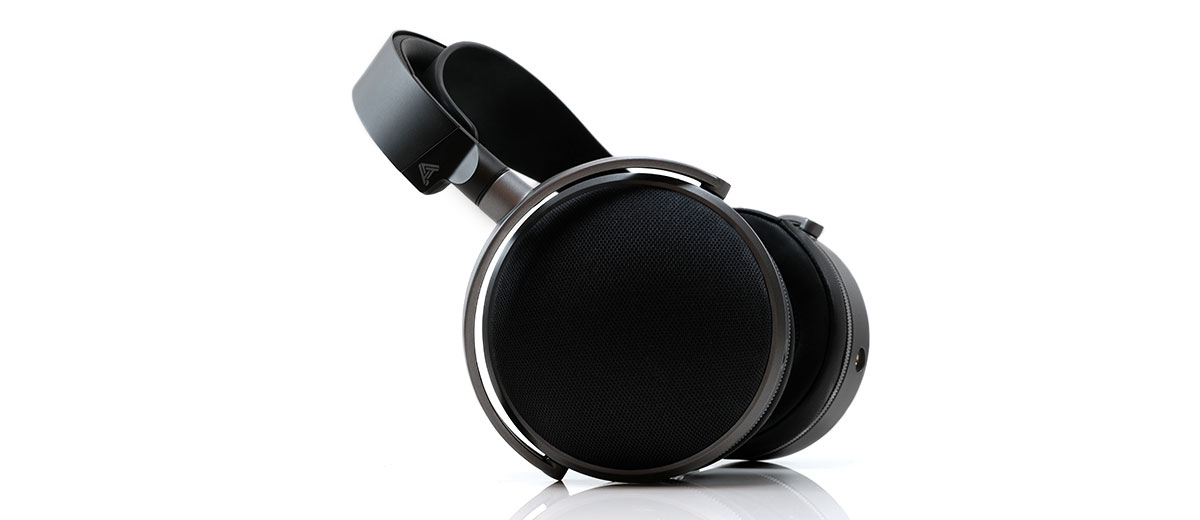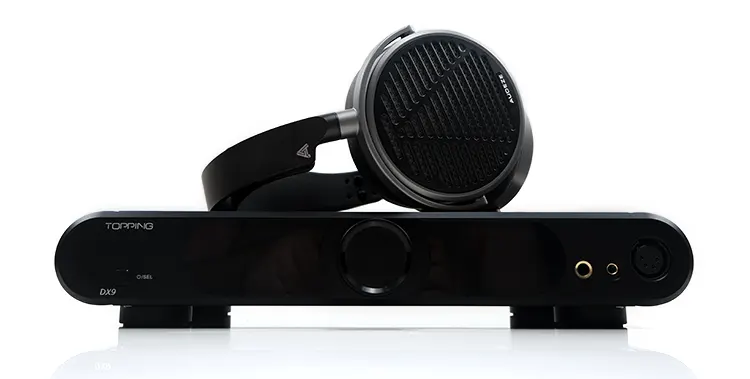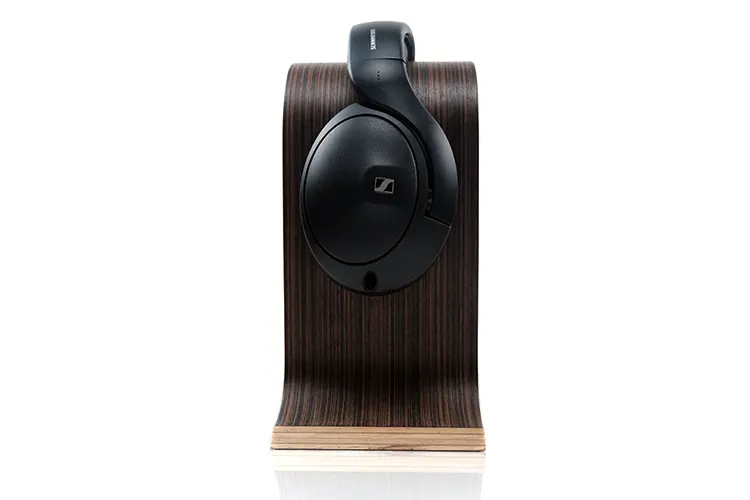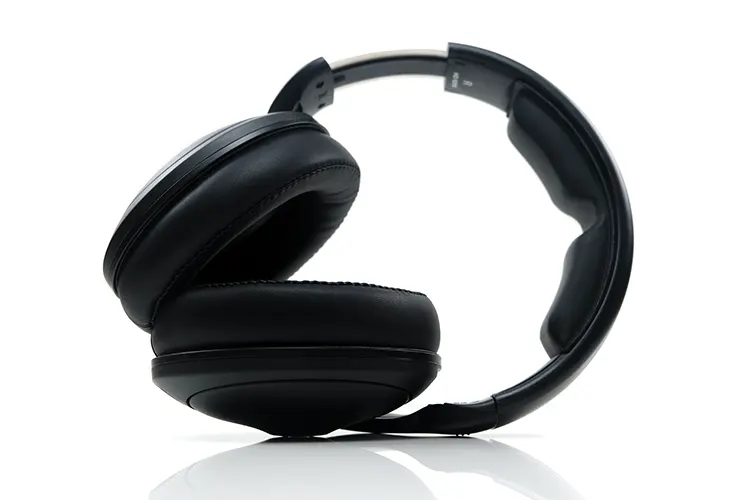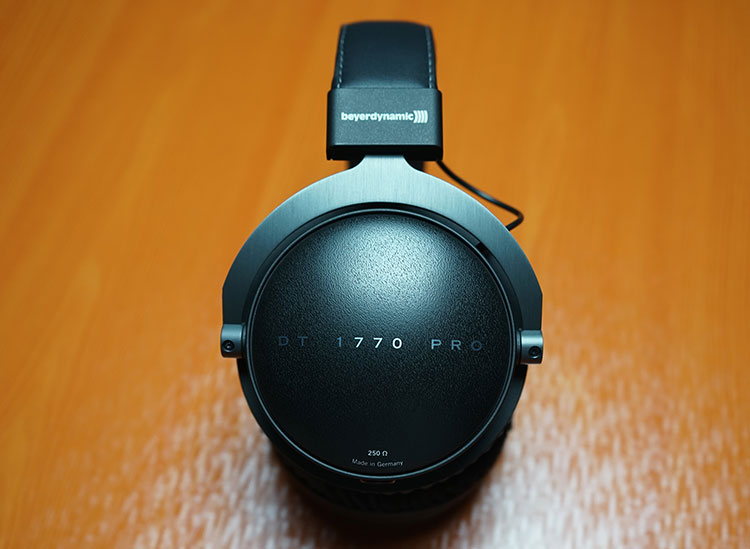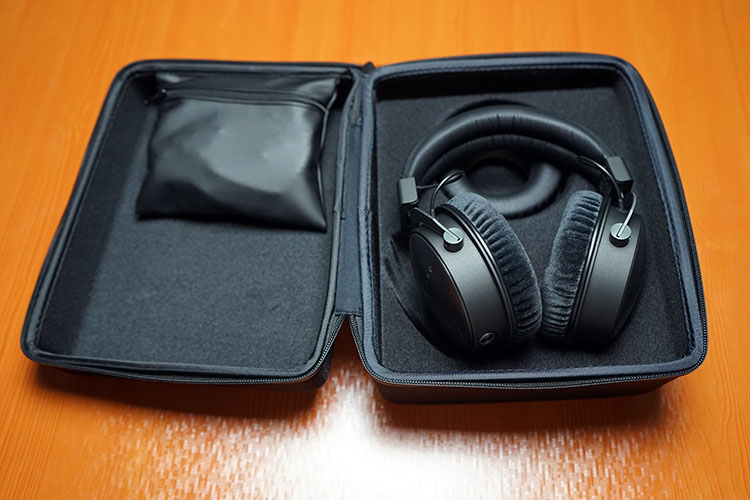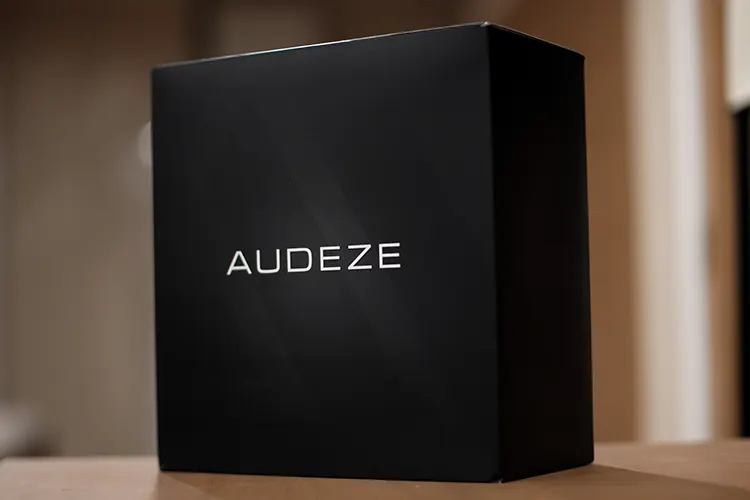Selected Comparisons
The following comparisons to the Audeze LCD-S20 were completed using a mix of the Ferrum OOR/HYPSOS/WANDLA GSE stack and the Cayin HA-2A headphone tube amplifier.
Audeze MM-100
The Audeze MM-100 was launched in the middle of last year, with my review published shortly after. It also received our 2024 Bang For Buck Editor’s Choice Award.
Technical
The MM-100 is the second Manny Maroquin-tuned open-back headphone, with the first being the high-end MM-500.
In some ways, despite being an open-back planar headphone as opposed to a closed-back one, the MM-100 is the closest cousin to the LCD-S20 despite not being an LCD headphone.
For example, both have 18Ω impedance rated 90mm planar drivers with Audeze’s in-house Fazer phase management, a dual-sided N50 Fluxor array, and an Ultra-Thin Uniforce diaphragm.
Where they differ greatly is in their sensitivity levels, with the MM-100 5 dB more sensitive at 98 dB/mW compared to 93 dB/mW, and the LCD-S20’s use of SLAM technology to allow for a weightier yet cleaner bass tuning inside a closed cup.
You can see the plate on which the SLAM physical grooves and venting port are integrated into the next deviation from the MM-100’s technical capability, the LCD-S20’s detachable pads system.
Design
Again, a lot of design language overlaps between these two headphones. We have the same materials with a magnesium frame, aluminum, spring steel, and a light smattering of refined plastics on the top of the headbands.
The key differences are the open-back grill design for the MM-100 and the fabric-covered closed cup of the LCD-S20, which I presume is made from a similar magnesium or aluminum material.
There are also some nuanced differences, with a slightly thicker leather pressure-balancing strap under the LCD-S20 headband arch. The MM-100 pressure strap feels a little softer and more malleable, so I wonder if this was changed to counter the enhanced weight of the LCD-S20.
The weight difference is noticeable at 475g for the MM-100 compared to 550g for the LCD-S20. I found the MM-100 slightly more comfortable due to the reduced weight but also the wider contact surface on its non-removable pads.
The LCD-S20 detachable pads are well designed, but the slightly narrower inner wall contact surface creates a little more focused pressure on the side of my head than the MM-100 pads.
Both headphones use the same dual-sided, single-socket entry system, which I find to be a boon for moving around my desk during work. Sometimes I want the cable on the left, and sometimes on the right; it all depends on which amplifier I want to use.
As for cable design, terminations, and wire choice, they are the same. The only accessory difference is the additional black cloth pouch that comes with the MM-100.
Performance
It’s all about the bass and closed-cup acoustics here and how Audeze has tuned the LCD-S20 to deliver what I consider to be a smoother, weightier tone but also a darker sound than the MM-100.
Given its an open-back, the MM-100 upper-register notes dissipate in a far smoother, more open manner. I wasn’t surprised by that difference given the different acoustical properties.
It would seem the Audeze understands the more limited staging height and openness by using SLAM to emphasize the low-end shelf of the LCD-S20 a lot more.
Up to 300 Hz, the LCD-S20 sounds the more muscular of the two headphones, enhancing depth and pulling your listening attention further down with a greater fundamental frequency focus.
The MM-100 is more neutrally colored. Though still what I would describe as energetic, its sound signature is characterized by a shallower but still fairly punchy bass response combined with a forward midrange with stronger ear gain around 2-3k.
Though by no means peaky at all, the MM-100 also has more noticeable treble fill from a stronger 3-8k elevation than the LCD-S20.
From 1-2k, the LCD-S20 has some good emphasis, but it’s overly forward or shouty to my ear, and acoustically, it can seem closer to the listener. I would describe the overall vocal imaging as intimate but still relatively relaxed compared to the more aggressive MM-100 voicing.
Given its more compressed staging quality and reduced comparative height, it’s a good decision to keep the LCD-S20’s mid-forwardness in check.
The resulting timbre is a big help here. The LCD-S20 might not have the sparkle and airiness of the MM-100, but the darker tone reduces some contrast and the potential for sibilance through the mids, creating a more agreeable quality to poorly recorded or brightly mixed music.
Sennheiser HD 620S
Like the MM-100, the Sennheiser HD 620S was launched in early 2024, with my review coming out shortly after. It also received the 2024 Bang For Buck Best Closed Headphones Award.
Technical
The HD 620S is also a closed-back circumaural headphone, but it uses a dynamic driver instead of a planar. Inside, the HD 620S uses a 42mm transducer with a 38mm diaphragm size combined with the company’s ultra-light aluminum voice coil.
As with many Sennheiser dynamic driver headphones, impedance is a big factor here, and yes, it’s quite a bit higher at 150Ω compared to the LCD-S20’s 18Ω rating.
The rating in itself does not mean that the HD 620S is hard to drive, given its driver’s maximum power rating is usually a bit over 200 mW. Indeed, the HD 620S SPL is just a hair under 102 dB/mW (110 dB/Vrms)
Rather, it’s the impedance matching with the amplifier where the HD 620S will come into its own, with OTL amplifiers in particular well-suited to the more voltage-demanding nature of these headphones. A good voltage swing does wonders for these headphones.
The LCD-S20 is the complete opposite. Voltage is not an issue, efficiency is great at 18Ω. However, good current is needed, and its sensitivity is much lower than the HD 620S. You will find yourself cranking up the volume considerably on most sources and amps when trying to compare these two.
Design
I kind of flip-flopped a little on whether the HD 620S had the better design or the LCD-S20. Which side you are on really depends on what you want out of your headphones.
If you want a lightweight headphone, then the HD 620S is 225g lighter, and that is a massive difference in the head and on your head. If you want the best passive isolation, the HD 620S has an edge.
However, that superior isolation comes at the cost of a stronger level of lateral clamping pressure from the HD 620S, whereas the LCD-S20 can feel a little looser on the side, and for some, that might feel more comfortable.
The ovoid inner pad opening on the HD 620S suits my ear shape a bit more than the LCD-S20 equivalent and helps to mitigate the effect of the lateral clamping.
Both pad types clear the ear quite well, but only the LCD-S20 offers an easy detachable pad system, which makes me feel that somewhere down the line, we will see different pad options from Audeze.
The aesthetics belong to the LCD-S20. Both feel sturdy, but the plasticky nature of the HD 620S feels and looks cheap compared to the premium magnesium, protein leather, and fabric mix of the Audeze design.
The cable design is also a bit of a win for the LCD-S20 with its dual-entry single-sided connector system, providing a lot more flexibility than Sennheiser’s single-sided proprietary twist-to-lock system. The cable’s locking mechanism makes it more difficult to ‘cable roll’ compared to the simpler Audeze system.
Performance
For sheer depth and power, the LCD-S20 reigns supreme in this comparison. The HD 620S is the punchier of the two, and its driver can seem a little quicker in impact than the bigger Audeze driver.
However, when recordings start reaching deep, there is no denying how more linear yet impressively weighty the LCD-S20 low-end response can sound.
As with the MM-100 comparison, the LCD-S20 does sound darker with a more rounded and richer tonal quality than the HD 620S once you go up through the range.
You will hear a more neutral tone through the mids, a bit more ear gain around 2-3k, and enhanced treble fill from the Sennheiser from 3-8k onwards.
That gives the Sennheiser more air and sparkle with a taller staging quality. However, it also means a lighter note with a weaker fundamental in the mids and subjectively more upper harmonic overtones in the upper mids and lower treble than the denser LCD-S20 timbre.
Now, I do not find the HD 620S spikey or hot in the upper mids and highs, but such is the darker nature of the LCD-S20 equivalent from 3-8k, the Sennheiser will seem the ‘peppier’ of the two presentations.
The imaging on both is really good, neither sounds like an old-fashioned closed-back headphone. Rather, the emphasis with the LCD-S20 pulls your ear more downwards with a stronger focus on power and depth, and the HD 620S focuses more on the punch and upper register instrumentation.
beyerdynamic DT 1770 PRO
The beyerdynamic DT 1770 PRO is now considered a legacy headphone, with the MKII recently coming out, but it has been a closed-back studio staple for almost 10 years now.
Technical
Another closed-back circumaural headphone and like the HD 620S, this has a dynamic driver as opposed to the LCD-S20’s planar variant.
I believe the DT 1770 PRO driver is a 2nd generation Tesla technology driver that began with the T1 over a decade ago. This one is a 45mm driver size with a Tesla strength neodymium magnet and is rated at 250Ω.
That is quite a significant difference from the 18Ω-rated LCD-S20 90mm planar driver, which will not require as much voltage as the DT 1770 PRO.
If anything, the beyer will be even happier with higher output impedance amps than the HD 620S. After all, it’s a studio purebred from a decade ago when high-impedance studio equipment was far more prevalent.
It is a more sensitive headphone than the LCD-S20, though. With an SPL of 102 dB/mW, you will get a louder performance from weaker sources than the 93 dB/mW-rated LCD-S20, which I found to sound more capable from higher-powered desktop or portable amplifier devices.
Design
The DT 1770 Pro is a smaller, lighter (338g), and more compact headphone than the LCD-S20, but does not have quite the same level of striking aesthetics.
However, its dowdy black ‘studio’ vibe combined with a sturdy mix of metal and plastics makes it one tough nut and ideal for rough studio use. It’s a common design language used on a lot of beyerdynamic headphones, and with good reason.
With the accompanying velour pads, it sits rock solid on my head, more so than the bigger and slightly looser LCD-S20. The DT 1770 PRO pressure balance on my head is excellent, yet surprisingly, the LCD-S20 passive isolation is on par with it, if not slightly better.
Both headphones have swappable pads, though the DT 1770 PRO uses a more traditional lip-and-ring system, which, while not that hard to use, is nowhere near as convenient as the magnetic system on the new LCD-S20 pads.
The DT 1770 PRO does come with 2 types of pads, velour and pleather, which affect the tuning. I have always preferred the more breathable velour pads and the sound they create over the pleather variants.
Both headphones use a single-entry cable system, though the DT 1770 PRO does not have the more creative dual-entry system of the LCD-S20. It’s a fixed, left-sided, 3-pin mini-XLR system with 2 single-ended cable choices as opposed to one: a straight 3m cable and a shorter coiled cable.
Performance
The DT 1770 PRO’s more walled-in or less open staging quality, with copious amounts of bass bloom to go along with it, gives it an even darker sound signature. than the LCD-S20.
The bass shelf on the DT 1770 PRO is not as deep but noticeably more enhanced around 50-100Hz with a strong 100-200Hz dip right after. It’s quite a specialist tuning, really more for mixing bass channels than for balanced listening purposes.
The LCD-S20 extends better sub-50Hz and has a far more linear bass response up to 2-3k, so it sounds enhanced but, at the same time, more balanced for general listening purposes.
It also sounds less claustrophobic with a more coherent transition into the lower mids than the DT 1770 PRO’s bloomy bass, which can overpower lower-midrange instrumental presence.
Like the LCD-S20, the DT1770 PRO has some dips in the upper-mids, but it sounds more pronounced from 2-3k, pulling back on upper-register vocal power and weight noticeably compared to the fuller LCD-S20 sound.
Vocals are fairly well isolated on the DT 1770 PRO with some elevation around 1-2k, but they lack the body and immediacy of the LCD-S20 vocal performances.
The LCD-S20 has more gain around 1-3k, pushing vocals a little further forward, but even then, it still does not sound as disconnected as the DT 1770 PRO midrange. I have said before that the DT 1770 PRO mids can sound unengaging, and it’s still the case here compared to the LCD-S20.
One final note on the highs. The DT1770 PRO has a more noticeable 5-6k peak that can bleed into mids and vocal performance, meaning it can be a little harsher than the LCD-S20’s more gentle approach to its lower mids tuning.
My Verdict
The Audeze LCD-S20 is a very competitive closed-back planar headphone at this price point. With the new SLAM technology, it has a deep low-end response without a typical closed-cup bloom, delivering impressive weight combined with a smooth, albeit slightly dark, sound signature.
MM-100 lovers will take to the design language quickly. Having not tested the Maxwell personally, I can only presume the fit and comfort levels will also provide a degree of familiarity to Audeze’s gaming fans.
Detachable pads are hugely welcome, and I hope this approach is going to permeate throughout Audeze’s higher-end headphone lineup in the future.
Honestly, although the LCD-S20 might have a lot of studio-like marketing collateral, this new sound feels like it will find a much bigger fan base in the everyday listening category.
Audeze LCD-S20 Technical Specifications
- Style — Over-ear, closed-back
- Transducer type — Planar magnetic
- Magnetic structure — Fluxor™ magnet array
- Magnet type — Neodymium N50
- Phase management — Fazor™
- Acoustic management — SLAM™
- Diaphragm type — Ultra-Thin Uniforce™
- Transducer size — 90 mm
- Maximum SPL —> 120 dB
- Frequency response — 10Hz – 40kHz
- THD — <0.1% @ 100 dB SPL, 1kHz
- Impedance — 18Ω
- Sensitivity — 93 dB/1mW (@ Drum Reference Point)
- Maximum power handling — 5W RMS
- Minimum power requirement —> 100 mW
- Recommended power level —> 250 mW
- Weight — 550g

